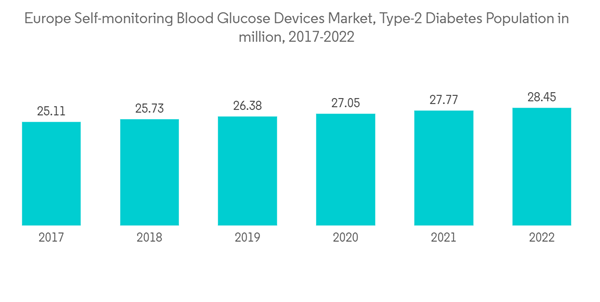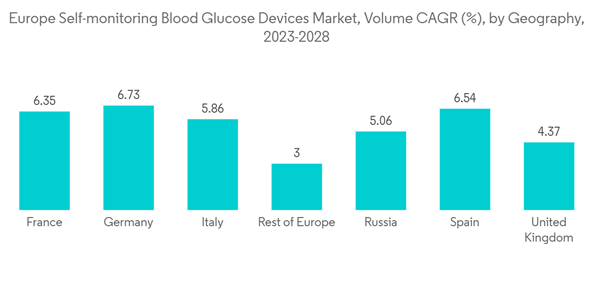The market is estimated to reach a value of more than USD 3.8 billion by 2027.
The COVID-19 pandemic has substantially impacted the Europe Self-monitoring Blood Glucose Devices Market. People with diabetes have a weak immune system so, with COVID-19, the immune system gets weaker very fast. People with diabetes will have more chances to get into serious complications rather than normal people. The manufacturers of diabetes care devices have taken care during COVID-19 to deliver diabetes care products to diabetes patients with the help of local governments.
Novo Nordisk stated on their website that 'Since the start of COVID-19, our commitment to patients, our employees and the communities where we operate has remained unchanged, we continue to supply our medicines and devices to people living with diabetes and other serious chronic diseases, safeguard the health of our employees, and take actions to support doctors and nurses as they work to defeat COVID-19.' Doctors around the world suggested diabetes patients should check their diabetes levels more often to be careful and the intake of medicine has increased, which lead to an increase in the usage of Self-monitoring Blood Glucose devices.
According to the diabetes category, the estimated cost per hospital admission during the first wave of COVID-19 in Europe ranged from EUR 25,018 for type 2 diabetes patients in good glycemic control to EUR 57,244 for type 1 diabetes patients in poor glycemic control, reflecting a higher risk of intensive care, ventilator support, and a longer hospital stay. The estimated cost for patients without diabetes was EUR 16,993. The expected total direct expenditures for COVID-19 secondary care in Europe were 13.9 billion euros. Diabetes treatment thus accounted for 23.5% of total expenditures.
European countries are suffering from the burden of high diabetes expenditure due to its rising prevalence. Technological advancements have increased over the period in Diabetes care devices for safer and more accurate measurement of blood glucose levels.
Therefore, owing to the aforementioned factors the studied market is anticipated to witness growth over the analysis period.
Europe Self-monitoring Blood Glucose Devices Market Trends
Increasing diabetes prevalence
The diabetes population in the European region is expected to rise by more than 5% over the forecast period.According to the IDF 2021 report, about 1 in 11 adults in Europe had diabetes, which accounted for approximately 61 million. These figures indicated that approximately 19.6% of global expenditures were spent on diabetes in Europe. Every year, 21,600 children are added to the type-1 diabetic population pool. The European region has witnessed an alarming increase in the prevalence of diabetes in recent years. Patients with diabetes require many corrections throughout the day for maintaining nominal blood glucose levels, such as oral anti-diabetic medication or the ingestion of additional carbohydrates, by monitoring their blood glucose levels.
The rate of newly diagnosed type-1 and type-2 diabetes cases is seen to increase, mainly due to obesity, an unhealthy diet, and physical inactivity. The rapidly increasing incidence and prevalence of diabetic patients and healthcare expenditure are indications of the increasing usage of insulin. Type-1 diabetic patients need to check their blood glucose levels at regular intervals, monitor their blood glucose levels, and adjust the insulin dosing accordingly. Innovative technologies, such as digital health apps that display and summarize individual blood glucose measurements and incorporate additional relevant data such as insulin doses, meals and snacks, and physical activity, can further support self-management while decreasing disease burden and benefiting overall diabetes care. Integration of blood glucose monitoring with insulin calculators, automated insulin titration software, and remote coaching are further developments that provide patients with poorly controlled diabetes with the additional support needed to improve critical outcomes, thereby enhancing market prospects in the years to come.
The government, along with the companies, are working towards better diabetes management. For instance, the National Service Framework (NSF) program is improving services by setting national standards to drive up service quality and tackle variations in care. The Association of British HealthTech Industries (ABHI) launched a diabetes section, enabling diabetes technology companies to work together in the first forum of its kind.
Therefore, owing to the aforementioned factors, the studied market is anticipated to witness growth over the analysis period.
Germany is expected to dominate the European Self-monitoring Blood Glucose Devices Market over the forecast period
Germany is expected to dominate the European self-monitoring blood glucose devices market and register the highest CAGR of about 6.9% over the forecast period.According to the German Diabetes Center (DDZ), about 8.5 million people in Germany are affected by diabetes. The number of people with type-2 diabetes in Germany will continue to increase over the next twenty years. Researchers at DDZ estimate that up to 12 million people might suffer from metabolic disorders in 2040.
According to the European Observatory on Health Systems and Policies 2021, Germany had the oldest social health insurance (SHI) system in the world. Health insurance is compulsory; people with an income above a fixed threshold or belonging to a particular professional group can opt out of SHI coverage and enroll in private health insurance (PHI). About 11% of the population is covered by PHI and 89% by SHI. Although coverage is universal for all legal residents, only 0.1% of the population does not have health insurance.
Various innovations in self-monitoring blood glucose device components are likely to increase the adoption of such devices. Lancets are typically used in blood glucose monitoring to draw out a small amount of blood from the patient for testing of glucose levels. The blood sample is dropped onto a test strip and inserted into a blood glucose meter for results. Various innovations in lancing devices offer a convenient way to draw blood samples. For example, Accu-Check FastClix has a preloaded lancet drum, so a person can load six lancets at a time rather than replacing the lancets after every use. The Accu-Chek FastClix also has a lever and a counter, so the user can easily move to the next lancet and see how many are left in the drum. Accu-Chek states that this model has 11 depth settings. There is also a locking system to prevent lancing accidents. The Accu-Chek FastClix comes with 102 lancets.
The aforementioned factors are anticipated to drive market growth over the analysis period.
Europe Self-monitoring Blood Glucose Devices Industry Overview
The European self-monitoring blood glucose devices market is fragmented, with a few major manufacturers having a global market presence and occupying a major share, like Abbott, LifeScan, Roche, Ascensia, etc., while the rest are confined to other local or region-specific manufacturers.Additional Benefits:
- The market estimate (ME) sheet in Excel format
- 3 months of analyst support
This product will be delivered within 2 business days.
Table of Contents
Companies Mentioned (Partial List)
A selection of companies mentioned in this report includes, but is not limited to:
- Abbott Diabetes Care
- Roche Diabetes Care
- LifeScan
- Arkray
- Ascensia Diabetes Care
- Agamatrix
- Bionime Corporation
- Acon
- Medisana
- Trivida
- Rossmax International
Methodology

LOADING...










